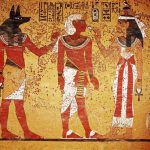Ancient Egyptian Cities 2022
We will know everything about these Ancient Egyptian Cities through this digital report in detail from the FTS blog.
The vast bulk of ancient Egyptian cities that flourished socioeconomically shared one feature: The Nile River. The Nile, the world’s longest river, served an essential but almost deity role for the ancient Egyptians. It fertilized cropland and helped fuel huge advances in technology for the tribal groups who revolved around this one. The majority of shipping routes also were linked through these cities.
A pretty standard ancient Egyptian city has been fenced in and had 2 huge gates along either side. Someone else distinct characteristic of those cities was the unsurfaced interlinking roadways that ran through the core of the towns. In terms of infrastructure, the Egyptians Built their residences out of mud brick. This substance was easy to find mostly around the Nile. Then we should know everything about Ancient Egyptian Cities
Ancient Egyptian Cities
Memphis
One of the Ancient Egyptian Cities is Memphis. Memphis has been Egypt’s 1st capital from 2950 BC to 2180 BC and is one of the official religious centers since it was the religious center for the sacred chord of the divine creator of Ptah, his wife Sekhmet, as well as Nefertem. Memphis is situated in lower Egypt, 15 miles south of contemporary Cairo. Just after the emergence of Thebes in Egypt’s new empire, Memphis’s social position turned down and it became a secondary capital (15570-1070 BC). Memphis was abandoned and faded away after the formal capital was transmitted to Alexandria throughout 331 BC, and also with the introduction of Christianity. Only just a few ruins remain today, such as an alabaster Sphinx and a monument of Ramses II.
Look here; Festivals in Egypt in 2022 That Depict the Traditions of the Country
Rosetta
Jean-Francois Champollion found the renowned Rosetta Stone in 1799 in this town. The Rosetta Stone is famous for becoming the crucial component to decoding the previously strange and unintelligible inscriptions. Rosetta, situated in Lower Egypt, was originally established in 800 AD and became a major trading city due to its strategy on the Nile and Mediterranean. It was once a multi-cultural coastal town with a monopolistic on delta-grown rice, but it ultimately turned down as Alexandria grew.
Thebes
All around the 22nd century BCE, the capital of the kingdom was decided to move from Memphis to Thebes during the rule of the king of very powerful rulers in Upper Egypt. Thebes beat the Herakleopolitan ruling elite as well as reconnected Bottom and Top Egypt underneath the rule of Nebhepetre Mentuhotep II.
Historians think the rapprochement occurred around 2055 BCE. It also heralded the arrival of the Middle Kingdom (2134 -1690 BCE). Thereby, Thebes remained the kingdom’s headquarters under many aristocracies till about 1279 BCE.
Thebes had to have an effective system for irrigation purposes its massive farmlands along the Nile. The city’s rulers also ensured that the city had a solid system of justice. All of these factors contributed to Thebes’ popularity throughout the known universe.
Thebes as well as Memphis were old Egypt’s two most important cities. Thebes has been similar to Memphis because it had operating city admins as well, trying to make it the political and religious center of ancient Egypt.
The Temples of Karnak in Thebes were very well for their devotion to the gods Amun-Ra, Aten, Montu, as well as the goddess Mut. Theban temples, such as the Temple of Luxor, have been thought to be the biggest temples already constructed in Egypt.
Some few miles from Thebes were the renowned Valleys of the Kings as well as the Valleys of the Royals. Just next to Thebes, you could also visit Tutankhamun’s tomb as well as the Colossi of Memnon.
Look here; How To Experience Luxury Trips in Egypt 2022
Aswan
Aswan, in Upper Egypt, is the site of the Nile River’s first cataract as it flows north to the Mediterranean. Aswan is home to the Temple of Isis as well as the Rock Monuments of Queen Nefertari as well as Ramses II. The Temples of Philae, as well as Abu Simbel, have been attacked by the building projects of the Aswan High Dam, so they were moved numerous 100 feet upriver for conserving.
Abydos (Abdju)
Abydos occurred before the Old Kingdom of Egypt (c. 2600-2180 BCE). That is the age of Abydos. The city was known as among the most sacrosanct cities in ancient Egypt. According to Egyptian mythology, the god Osiris was entombed in Abydos after being assassinated by his frustrated brother.
Crocodilopolis (Faiyum)
Crocodilopolis, as the name suggests, was a city dedicated to the devotion of the crocodile god Sobek. Crocodilopolis is a Greek city.
Crocodilopolis’ first residents are thought to have arrived approximately 4,000 BCE. As a consequence, numerous historians think this to be one of Egypt’s oldest settlements. In modern times, the city is known as Faiyum.
Heliopolis
Heliopolis was the biggest city and also the most important religious center in ancient Egypt during the which was before period. The ancient Egyptians believed it was the original home of Atum, the sun god, and the Ennead of Heliopolis, which also included Isis, Geb, Atum (Ra), Nut, Osiris, Set, Tefnut, Shu, and Nephthys. This same Monastery of Re-Atum obelisk, situated in severe Lower Egypt, seems to be the only old statue that has survived.
The city of Amarna
Amarna, one of old Egypt’s lesser-known capitals, covers a time of major religious conflict and finds it difficult in Egyptian history.
Thinis
Thinis was the capital city of Upper Egypt before this was reassigned to Memphis. First Ancient Egyptians were entombed here, and Thinis declined in significance just after the 3rd dynasty. Thinis, the religious movement center of the war god Anhur, was never discovered as an ancient excavation, despite being very well by ancient writers.
Look here; Ancient Egyptian Mythology updates 2022
Avaris
Avaris, situated in Lower Egypt, served as Egypt’s capital during the 15th Ruling family when this was ruled by the Hyksos. The Hyksos were foreign nationals who inhabited the land before seizing control. Archaeologists have found a mud-brick high ceilings tomb that rightfully belongs to a warrior and was entombed with his weapons, such as a best-preserved copper sword, in contemporary Tel El-Daba.
Nubt (Kom Ombo)
Nubt was primarily an agricultural city that was well-known in ancient Egypt for accommodation the Temple of Kom Ombo. Kom Ombo managed to hold strategic significance to both Ancient Egypt and also Nubians as an ability to trade path city decided to merge among Egypt and Nubia (what was then northern Sudan and southern Egypt). The Egyptians called the city Nubt, which also implies “golden city.” This title alludes to the city’s vast precious metals and other valuable minerals. Sobek, the crocodile god, has been Kom Ombo’s deity.
Elephantine
Elephantine, an island in the River Nile among Egypt and Nubia, is now part of Aswan. Khnum, State, as well as their daughter Anuket worshipped there. Hapi, the Nile River’s floods god, has been born.
Hermopolis
A significant religious center that worshipped Thoth as the creator god. The ancient Egyptians named this religious movement center in Upper Egypt Khmun. Hermopolis is famous for the Hermopolitan Ogdoad, which also tells the story of 8 gods who made the earth, four pairs of men and women. Amun as well as Amaunet, Huh and Hehet, Kek and Keket, as well as Nun and Naunet were among these couples.
Yamu
Yamu was a town in Egypt that existed from the Old Kingdom to the Middle Kingdom. Yamu played an important role in the motion of cattle in Egyptian Civilization. Yamu was the location of Khesuwer’s renowned tomb. The city was home to the Temple of Sekhmet, which was devoted to Hathor, the Egyptian pharaoh’s air religious figure as well as spiritual mom.
Saqqara
Saqqara, situated in Lower Egypt, was an old burial site. The Step Pyramid of Djoser, also recognized as the Step Tomb, is among the most renowned constructions. Approximately 20 ancient Egyptian kings build the pyramids here, which also did serve as a cemetery for Memphis’ kings living and dying.
Alexandria
From 332 BC to 641 AD, Alexandria was represented as Egypt’s capital. This same city was built by Alexander to become the new headquarters for Ancient Greece culture to the new worlds of Africa, the Mideast, and well beyond. The city stretches for 32 kilometers all along the Mediterranean coast and is 138 kilometers (114 miles) part of the north of Cairo.
Somewhere around 285 BC and 247 BC, the city was renowned for housing the celestial reading room of Alexandria, which held approximately 100,000 to 400,000 papyrus scroll inscriptions in literary works, scientific knowledge, pharmaceutics, and any other topic imaginable. Julius Caeser consumed the reading room in 48. The city has been famous for housing one of the Seven Wonders of the Ancient World, the Viewing platform of Alexandria, which was the world’s highest man-made framework at the time. This was built between 284 BC as well as 246 BC and was destructed by three earthquakes between 956 AD & 1323 AD.
In Closing
We knew the whole thing about the Ancient Egyptian Cities in detail through the previous points and we hope you like it too much mate.








